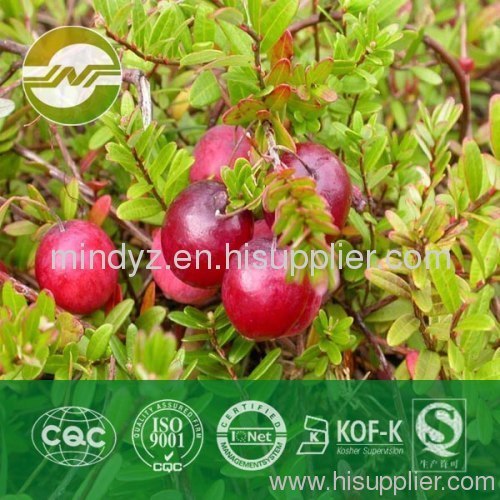cranberry extract
Latin name: Vaccinium Macrocarpon L.
Specifications:Anthocyanidins 5%,10%,25%,UV.
Proanthocyanidins (PAC) 25%,50%,UV.
Health benefits and potential health benefits:
Nutrients and antioxidant capacity
Cranberries have moderate levels of vitamin C, dietary fiber and the essential dietary mineral, manganese, as well as a balanced profile of other essential micronutrients.
Raw cranberries and cranberry juice are abundant food sources of the anthocyanidin flavonoids, cyanidin, peonidin and quercetin. These compounds have shown promise as anti-cancer agents in in vitro studies. Cranberries are a source of polyphenol antioxidants, phytochemicals under active research for possible benefits to the cardiovascular system and immune system, and as anti-cancer agents.By measure of the Oxygen Radical Absorbance Capacity with an ORAC score of 9,584 units per 100 g, cranberry ranks near the top of 277 commonly consumed foods in the United States.
Since 2002, there has been an increasing focus on the potential role of cranberry polyphenolic constituents in preventing several types of cancer. In a 2001 University of Maine study that compared cranberries with twenty other fruits, cranberries had the largest amount of both free and total phenols, with red grapes at a distant second place. Cranberry tannins have anti-clotting properties and may reduce urinary tract infections and the amount of dental plaque-causing oral bacteria, thus being a prophylaxis for gingivitis.
Cranberry juice contains a chemical component, a high molecular weight non-dializable material (NDM), as noted above, that is able to inhibit and even reverse the formation of plaque by Streptococcus mutans pathogens that cause tooth decay. Cranberry juice components also show efficacy against formation of kidney stones.
Anti-adhesion properties
There is potential benefit of cranberry juice consumption against bacterial infections in the urinary system. Research shows that an effect occurs from a component of the juice inhibiting bacterial attachment to the bladder and urethra.
The Cranberry used in dietary supplements is derived from the fruits of Cranberry (Vaccinium macrocarpon L.).
Benefits
- Antioxidant Effect
- Radical-Scavenging Effect
- Anti-cancer
- Anti-adhesion properties and Anti-bacteria infections in the urinary system
- Cardiovascular Protection
- Inhibit Obesity
- Inhibit Diabetes
- Tooth Protection Effect
Mechanism
Anthocyanidins have putative antioxidant and radical-scavenging effects which may protect cells from oxidative damage and reduce risk of cardiovascular diseases and cancer. One theory is that dietary intake of Anthocyanidins may inhibit development of obesity and diabetes as well as contain inflammatory mechanisms. And it is said it have eyesight improving effects. Other studies have generally shown that the glucoside derivative of Anthocyanidins may have a role in cancer therapy.
Other Mechanisms refer to the above information.
Safety
Cranberry is safe.
Possible contraindicationsAn autumn 2004 caution from the Committee on Safety of Medicines, the UK agency dealing with drug safety, advised patients taking warfarin not to drink cranberry juice after adverse effects (such as increased incidence of bruising) were reported, possibly resulting from the presence of salicylic acid native to polyphenol-rich plants such as the cranberry. However, during 2006-8, several reviews of case reports and pilot studies have failed to confirm this effect, collectively indicating no statistically significant interaction between daily consumption of 250 mL cranberry juice and warfarin in the general population. A gene (VKORC1, CYP2C9) has been shown to change warfarin sensitivity. This gene may also contribute to bruising susceptibility as a result of cranberries for carriers of the gene.
Dosage
-The typical dose is 300-900mg per day (usually in 2-3 doses throughout the day).
-Consult physicians for different condition specifics.









